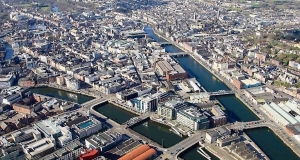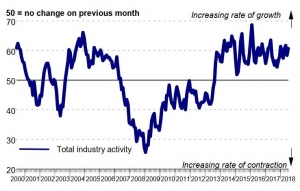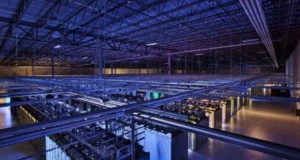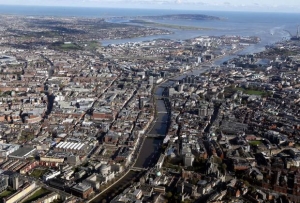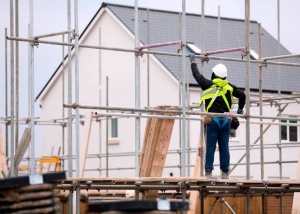Smart Cities Are Coming, and They’ll Need Data Centers
Smart cities are a key component of our digital future, bringing together the Internet of Things, BigData, artificial intelligence and self-driving cars to change the way we live and do business in major urban centers.
The smart city is an urban development that integrates information technology and the Internet of things (IoT) into the fabric of city life, using analytics and sensors to better manage cities and make urban ife safer, more efficient and sustainable. It’s just one more expression of how next-generation technologies are remaking the American landscape.
A lot of those early investments are in smart lighting projects, which can piggyback on a larger trend to convert legacy streetlights to LED to reduce energy costs.
The expo hall at Internet of Things World stretches across much of the Santa Clara Convention Center. As you walk past booth after booth of connected things, it’s a dazzling array of IoT tech. Some of it is super cool, while some leaves you scratching your head.
In an era of tight budgets for cities and counties, a key question is how governments will fund their investment in smart city initiatives.
What does this mean for data center economics? A number of developers and service providers are positioning themselves to benefit from demand for urban IT infrastructure. Smart cities are a particular flavor of edge computing, with the accompanying focus on right sizing the data center form factor.
Cork to be fastest growing Irish city over the next 20 years
Irish construction experiences sharp increase in activity
In a recent interview with The Irish Times, Apple chief executive Tim Cook also said the tech giant may consider locating another data centre in Ireland when its requirements dictated that Apple needed to expand its data centre capacity. “We don’t plan on stopping growing, and so things will come back around at some point in time,” he said.
1,200 more homes as Dublin steps up social housing push
"We support the proposals by Dublin City Council's head of housing, deputy chief executive Brendan Kenny, for a large-scale rezoning of industrial estates in central Dublin for new housing, as this would transform the landscape of the city,” said Kidd. “We want to build thousands of new energy efficient homes and retrofit thousands of old housing stock to help solve the social housing crisis once and for all. We have secured the finance for the project. Now we want to work with the council to help deliver it.”
"All our businesses are now either achieving industry-standard margins or on track to do so in the second half," Leo Quinn, CEO of Balfour, said.
Dublin’s housing crisis brings silver lining for the regions
But whatever way you slice it, the influx of FDI into Dublin has been a huge part of the region’s development and getting firms to look at other locations has been a difficult sell for the IDA. As the agency’s own 2017 end-of-year statement put it: “Convincing international investors to consider locations outside of Dublin continues to prove challenging with multinational companies increasingly looking to invest in bigger communities globally.”
These rents are creating a huge social problem – and also an economic blockage. The level of pay employees require to be able to afford to rent – and live – is rising and this is tipping the scales for many firms. Attracting people to come and work in Dublin for €45,000-€50,000 is now problematic, because of the cost of housing. On any calculation, paying over €1,500 a month is going to stretch someone earning €45,000 a year or even €50,000. This has swung the dial for some companies in favour of regional locations.
If you work in technical recruitment or even engineering jobs then you will know how exciting it is when new projects like this come on the market. After all, everyone benefits and it is only a matter of time until other people start to follow in the footsteps of those who are making headlines. Engineers have devised a method to try and combine disparate materials. In other words, this means that you can have the best of both worlds when it comes to laser material. Any material that is capable of producing laser light need to meet certain requirements. Researchers have found a way to try and combine alumina crystals with a substance known as neodymium. The ions for this have the ability to produce a very high-powered pulse and this can be done across a huge range of wavelengths.
Another great benefit? It has the ability to resist thermal shock as well. Now both neodymium and even alumina are very common materials when you look at solid state lasers. The former gives you the chance to make the metal ions that are required for the light and the other is designed to withstand heat. The problem is that the two of them are incompatible.
That is, until now. Researchers have found a way to try and combine these two ions and substances so that a high-powered laser can now be operated to the maximum efficiency without any worry. The researchers over at the university have been working very hard on this project and they have also really put the work in to try and make sure that the final project version is viable as well. So far everything looks to be good and this could make a huge difference to the industry.
A 1.5 Billion Euro Power Investment is Happening in Portugal
Northern Portugal is now starting to receive an economic boost. This is all down to the latest announcement- stating that a hydro powerplant is going to be established in the Douro Valley. Iberdola is commencing the build for three brand new dams. This would mean that power could be produced in the area and there is even going to be a pumped storage facility as well. Those who work in engineering jobs or even technical recruitment will know what a fantastic move this could be and it is going to take advantage of the fact that the water rises in Spain, before it flows over to Portugal. The development of the scheme is going to involve three core strategic undertakings.
After all, there is going to be a brand-new storage facility and there is also going to be a brand new capacity as well. This, combined with the fact that the pumped hydro is the only technology that is able to store large amounts of energy efficiently means that the whole project is very exciting to say the least. This just goes to show that the area is very focused when it comes to sustainable development and it also shows that people in the area are doing everything they can to really make the most out of the planet.
The three dams combined are expected to produce around 1,760 GWh and this is going to happen every single year. They are going to serve the Iberian market and they are estimated to create around 13,500 jobs when the construction phase begins. This is very exciting news and it is great for those who live in the local area as well as it means that the economy will surely benefit from this.
Material is Being Formed from Crab Shells and It Could Put an End to Plastic Packaging
There have been a lot of experiments done lately to try and cut down on the amount of plastic that we are pumping out into our oceans and it seems as though a possible solution has been found. J. Carson Meredith who is a professor at the Georgia Tech School has come out to say that there is a new material that could replace the need for plastic. This is made from crab shell, otherwise known a chitin and it also uses cellulose as well which comes from tree fibres. Multiple layers of chitin are used to create a flexible yet firm alternative to standard plastic film.
As we all know, cellulose is the most well-known form of biopolymer and this is great news for those who work in technical recruitment or even engineering jobs. To create the plastic alternative, the team over at the university created a method that involved suspending cellulose and chitin in water. They were then sprayed on a surface in layers, alternating one another. When the whole thing had dried, the result is a flexible yet strong, fully transparent alternative to plastic. The best thing about it? It is fully compostable as well!
J. Carson Meredith is the person who led the research and they have come out to say that this could actually have some advantages over plastic. It has a lower level of oxygen permeability and this means that it could actually help to keep food fresher, for longer. With that being said, more and more companies are now trying to put an end to plastic usage and they are also doing their best to try and stop the amount of plastic being released into the environment as well. This could be a worthwhile solution.



